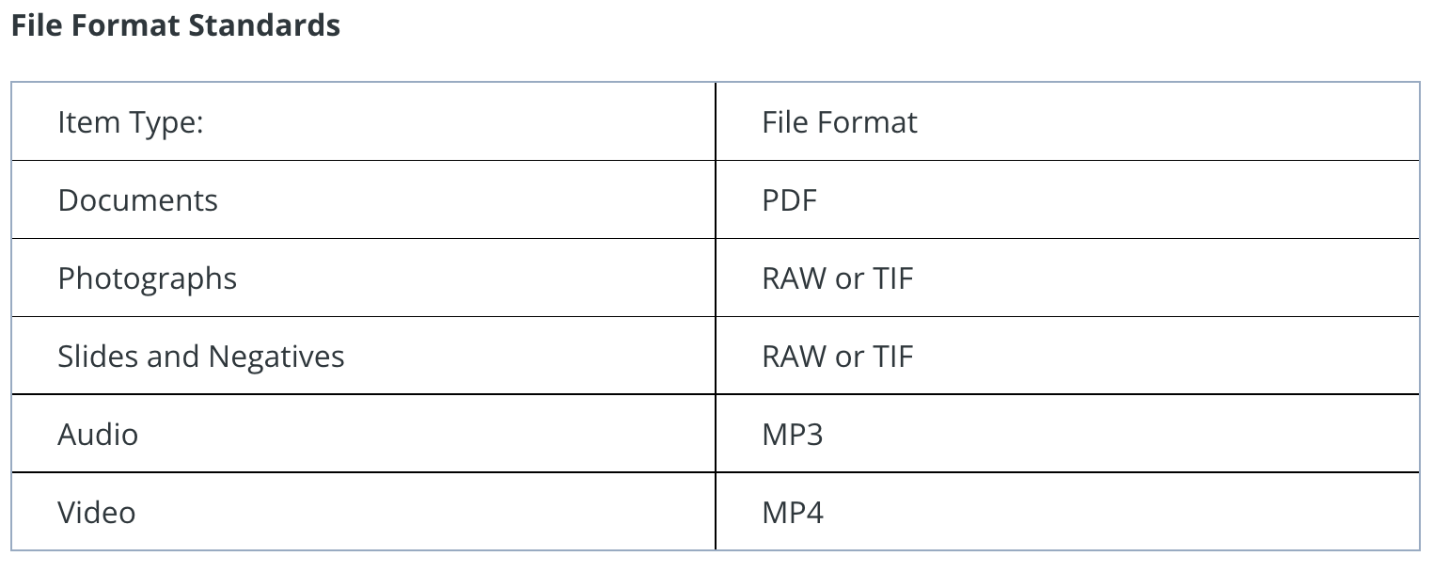Museum Digital Projects: Standards to Follow

Rachael Cristine Woody
Continuing our follow up to the “Ask Me Anything: Museum Digital Projects” webinar, this post will address questions we received subsequently in order to provide additional insight, strategies, and resources.
Our thanks to everyone who sent in questions! Your participation helps us to craft future content that is of the most use to you, our colleagues.
Today’s Post
Today’s post will focus on standards to follow when conducting museum digital project work. Specifically, we will cover quality, file format, and metadata (cataloging) standards as the most common standards to consider for digital project work.
Q. I’m new to the field and work in a museum that has inconsistently digitized things in the past. I want to establish some standards to follow. What standards or best practices already exist that I can incorporate?
Consider the following elements:
- Standards for digitization quality and file formats evolve over time.
- It’s a balance of digitizing at a high resolution and managing files that aren’t so large that storing them is impossible.
- The following grid contains the current standards:
Digitization resolution (quality) and file format standards is dictated by item type. The first table outlines the common museum item types you may be digitizing. The middle column stipulates the minimal quality resolution for that item type, and the final column identifies an ideal resolution for that item type.

This second table outlines item types on the left with a recommended file format on the right. These file formats have been selected by preservationists in the field because of each format’s ability to remain intact and be accessed—agnostic of any proprietary software.

Q. What are the best practices for large format items – posters and topographic maps.
All large items—architectural drawings, maps, posters, etc.—will require a wide format scanner. These scanners are large and free-standing scanners and typically come with a feed mechanic. They tend to run $5,000-$15,000 dependent upon size and model, so unless your collection has a huge cache of these it’s usually cost prohibitive to invest in one. If this is the case for your museum then consider working with a digitization vendor who already owns the proper equipment. If you only have a few items then it may be worth reaching out to a college or university, an architecture firm, or other organizations who likely have a large format scanner and wouldn’t mind providing limited access to their tool.
Now, in terms of standards you’re going to be dealing with large files and you will naturally need higher resolution capture given the sheer amount of detail at this size. Depending on the item and what you intend to use the digital surrogate for, you may be considering architectural or topographical programs and, therefore, specialized file types. If your focus is preservation, access, and even reproduction; then capturing the files as a visual format (TIF) is best, with PDF as an alternative consideration.
Q. What are the best standards to follow for metadata?
Unlike libraries and archives, the museum field has several options and tends to be less regulated. Often, cataloging rules are predicated on the type of collections held at the museum, as opposed to universal rules adopted by the field. The following are fields commonly used to capture important object data:
- Object Identification Number (must be unique, usually the accession number)
- Object Title
- Object Creator
- Object Description
- Object Provenance
- Object Materials & Format
- Object Size
- Object Location
It’s important for the museum to determine which fields are required or recommended within the catalog record, and how field content should be entered. For example, the title field should use headline capitalization and the description field must use full sentences, spell out acronyms, and use proper grammar. In addition to object-specific information, the catalog record should also include controlled vocabularies to help identify and cross-reference related materials through: classification, creator, subject, taxonomy, and other term delineations. Commonly recognized vocabularies are: Art and Architecture Thesaurus, Library of Congress, Nomenclature for Museum Cataloging, and Chenhall’s Nomenclature.
Conclusion
In order to encourage consistent quality of work during the digital project I highly recommend you codify your own set of standards in a format and language that makes the most sense to those doing the work. Visuals (screenshots, real-life examples) paired with text tend to be the most effective, and having the standards in a format that’s easy to glance at for confirmation will help to keep your digital projects on track and done according to professional best practices.

Rachael Cristine Woody
Consultant, author, and blogger Rachael Cristine Woody advises on museum strategies, collections management and grant writing for a wide variety of clients. Learn about Lucidea’s Argus solution for museum collections management and digitization and read more of Rachael’s blog posts here.
Never miss another post. Subscribe today!
Similar Posts
Museum Collections Online with Accessibility Principle 2: Operable
Compliance with WCAG Version 2.1 Principle 2: Operable
Museum Collections Online with Accessibility Principle 1: Perceivable
Compliance with WCAG Version 2.1 Principle 1: Perceivable, affecting information published from museum CMS to an online portal; expert guidance
Accessibility Standards for Museum Collections Online
A museum’s compliance with the ADA Title II 2024 update has benefits for its online content and for the museum’s community of users.
Museum TrendsWatch 2024: Digital Twins and Doom Loops & Combatting the Loneliness Crisis
Digital Twins is the construction of a digital surrogate for a person, place, or thing—one of several new concepts and trends in the museum sector.




Leave a Comment
Comments are reviewed and must adhere to our comments policy.
0 Comments